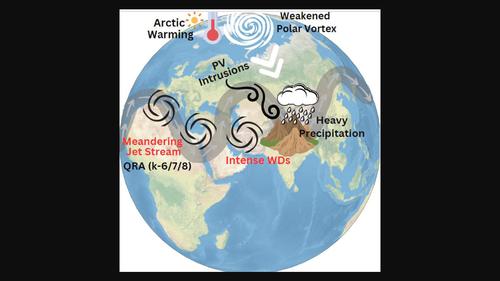当前位置:
X-MOL 学术
›
Q. J. R. Meteorol. Soc.
›
论文详情
Our official English website, www.x-mol.net, welcomes your feedback! (Note: you will need to create a separate account there.)
Underlying physical mechanisms of winter precipitation extremes over India's high mountain region
Quarterly Journal of the Royal Meteorological Society ( IF 8.9 ) Pub Date : 2024-02-14 , DOI: 10.1002/qj.4661 Nischal 1 , Raju Attada 1 , Kieran M. R. Hunt 2, 3 , Mathew Barlow 4
Quarterly Journal of the Royal Meteorological Society ( IF 8.9 ) Pub Date : 2024-02-14 , DOI: 10.1002/qj.4661 Nischal 1 , Raju Attada 1 , Kieran M. R. Hunt 2, 3 , Mathew Barlow 4
Affiliation

|
Extreme precipitation events (EPEs) are among the most pervasive weather hazards in the western Himalayan region (WHR), posing widespread damage to life, infrastructure, and agriculture. This study investigates the synoptic and large-scale characteristics linked to winter precipitation extremes over the WHR. EPEs are identified as events surpassing the 95th percentile threshold. A composite analysis is employed using two reanalyses—the fifth-generation European Centre for Medium-Range Weather Forecasts Reanalysis (ERA5) and the Indian Monsoon Data Assimilation and Analysis (IMDAA)—to elucidate the synoptic conditions conducive to EPEs. Our findings suggest that EPEs in the WHR are linked to an intensified subtropical westerly jet, characteristically shifted to south than normal. Enhanced kinetic energy in the upper troposphere, attributed to increased baroclinic instability, reinforces moisture convergence and strengthens synoptic-scale circulation, triggering deep convection and supporting EPEs. Notably, the interplay of pronounced Rossby waves sinking over the WHR and regional orography significantly modulates the intensity of western disturbances (WDs). Employing clustering analysis, we observed that the strongest EPEs are linked to anomalous vorticity in the upper to middle troposphere, together with deep convection via strengthened WDs, suggesting the potential role of large-scale influences. Using Lagrangian method, we identify that the Arabian Sea is the primary moisture source for EPEs in the WHR. We further delved into the role of large-scale connections and EPEs through quasi-resonant amplification (QRA) analysis. The findings unveil distinct QRA fingerprints in meridional temperature gradients along with notably magnified, quasi-stationary midlatitude planetary waves characterized by zonal wave numbers 6/7/8 (baroclinic waves) contributing to EPEs. Overall, our results highlight the underlying physical mechanisms for winter precipitation extremes, emphasizing QRA's role in amplifying planetary waves and promoting EPEs, underscoring the WHR's vulnerability to evolving climatic conditions.
中文翻译:

印度高山地区冬季极端降水的潜在物理机制
极端降水事件(EPE)是喜马拉雅西部地区(WHR)最普遍的天气灾害之一,对生命、基础设施和农业造成广泛损害。本研究调查了与西HR 冬季极端降水相关的天气和大尺度特征。EPE 被确定为超过第 95 个百分位数阈值的事件。采用两种再分析(第五代欧洲中期天气预报再分析中心(ERA5)和印度季风资料同化与分析(IMDAA))进行综合分析,以阐明有利于 EPE 的天气条件。我们的研究结果表明,西冷区的 EPE 与副热带西风急流增强有关,其特征是比正常情况向南移动。由于斜压不稳定性增加,对流层上层动能增强,增强了水汽辐合并加强了天气尺度环流,引发深层对流并支持 EPE。值得注意的是,明显的罗斯贝波下沉到西高岭和区域地形的相互作用显着调节了西部扰动(WD)的强度。采用聚类分析,我们观察到最强的 EPE 与对流层中上层的异常涡度以及通过增强的 WD 产生的深层对流有关,这表明大规模影响的潜在作用。使用拉格朗日方法,我们确定阿拉伯海是 WHR 中 EPE 的主要水分来源。我们通过准谐振放大 (QRA) 分析进一步深入研究了大规模连接和 EPE 的作用。研究结果揭示了经向温度梯度中独特的 QRA 指纹,以及显着放大的准静止中纬度行星波,其特征在于纬向波数 6/7/8(斜压波)对 EPE 的贡献。总体而言,我们的结果强调了冬季极端降水的潜在物理机制,强调了 QRA 在放大行星波和促进 EPE 方面的作用,强调了 WHR 对不断变化的气候条件的脆弱性。
更新日期:2024-02-14
中文翻译:

印度高山地区冬季极端降水的潜在物理机制
极端降水事件(EPE)是喜马拉雅西部地区(WHR)最普遍的天气灾害之一,对生命、基础设施和农业造成广泛损害。本研究调查了与西HR 冬季极端降水相关的天气和大尺度特征。EPE 被确定为超过第 95 个百分位数阈值的事件。采用两种再分析(第五代欧洲中期天气预报再分析中心(ERA5)和印度季风资料同化与分析(IMDAA))进行综合分析,以阐明有利于 EPE 的天气条件。我们的研究结果表明,西冷区的 EPE 与副热带西风急流增强有关,其特征是比正常情况向南移动。由于斜压不稳定性增加,对流层上层动能增强,增强了水汽辐合并加强了天气尺度环流,引发深层对流并支持 EPE。值得注意的是,明显的罗斯贝波下沉到西高岭和区域地形的相互作用显着调节了西部扰动(WD)的强度。采用聚类分析,我们观察到最强的 EPE 与对流层中上层的异常涡度以及通过增强的 WD 产生的深层对流有关,这表明大规模影响的潜在作用。使用拉格朗日方法,我们确定阿拉伯海是 WHR 中 EPE 的主要水分来源。我们通过准谐振放大 (QRA) 分析进一步深入研究了大规模连接和 EPE 的作用。研究结果揭示了经向温度梯度中独特的 QRA 指纹,以及显着放大的准静止中纬度行星波,其特征在于纬向波数 6/7/8(斜压波)对 EPE 的贡献。总体而言,我们的结果强调了冬季极端降水的潜在物理机制,强调了 QRA 在放大行星波和促进 EPE 方面的作用,强调了 WHR 对不断变化的气候条件的脆弱性。



























 京公网安备 11010802027423号
京公网安备 11010802027423号